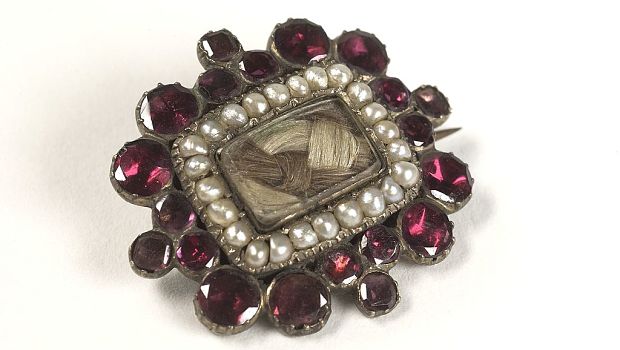Mourning jewellery is valuable today
‘If these mortuary jewels were as a whole very ugly, what shall be said of the hideous lumps of crudely manufactured jet, which it is still considered by some classes of society to be necessary to wear when ‘in mourning’…” Thus moaned Bertram S Puckle in his book Funeral Customs (1926). Mourning jewellery, so popular in the 19th century, was by then going out of fashion. This couldn’t happen quickly enough for Mr Puckle, who griped that Whitby, the seat of the jet industry, still carried on a trade in “these ghoulish appendages, impervious alike to enlightenment or ridicule”.
However bizarre it may seem today, when your loved one died, one of the first things you did was go out and buy some suitably macabre jewellery to keep close to your person. More bizarre items included replacing a man’s watch chain with a long length of his braided departed sweetheart’s hair. Hair was also displayed in rings. Jewellery items were made in gothic black (for death) and crafted picture panels often included skulls and graveyard scenes.
The Victorians were particularly attached to their mourning jewellery and, unlikely as it now seems, much of it was made of coal. Jet is a lightweight form of lignite, formed from the wood of pre-historic trees. Jet was big business. In England, it was mined and processed in Whitby where, by 1873, the trade employed 1,500 workers, not counting the further 200 engaged in mining the raw material.
If Mr Puckle was around now, he’d be laughing on the other side of his face. Jet jewellery from the Victorian era can be worth a considerable amount of money.
“Jet looks almost like black plastic but it can have a similar value to pearls or coral,” says the jeweller Garrett Weldon.
He admits that jet can be difficult to identify. It is always black, weighs very little, and is warm to the touch. When polished, it tends to glow rather than shine like glass. These qualities made it the material of choice for Victorian mourning jewellery – always black but never shiny.
Victorian women were expected to mourn their deceased husbands for a period of four years. They could graduate from ‘full mourning’ – a period in which they wore all black – to ‘half mourning’ when more muted colours were permitted. Some chose to wear black for the rest of their lives.
The customs and etiquette around mourning were at their most intense following the death of Prince Albert, husband of Queen Victoria of England, in 1861. Victoria wore black for the rest of her life, and her subjects followed suit with a rigorous dress code for their own bereavements.
In the first stage of mourning, which lasted a year and a day for widows and widowers, jet or black amber was the only type of jewellery allowed.
In Ireland, where there was no jet to be mined, mourning jewellery was often made of bog oak. “Bog oak pieces can be even more valuable than jet, but they are easily damaged,” says Weldon.
Because bog oak is light, it was a popular material for brooches and was often carved with Irish motifs like shamrocks and castles. According to Weldon, even a simple piece of 19th century mourning jewellery in bog oak might be worth a couple of hundred euros.
If you find a very fine piece in mint condition, it could be worth thousands. Materials considered suitable for ‘half-mourning’ included jewellery made from the hair of the deceased. Many pieces of jewellery, like lockets, opened to reveal a glass compartment where a lock of hair could be stored.
In other pieces, human hair became the predominant material. The hair was boiled, sorted into lengths and plaited around a mould, using a series of bobbin and weights. When the weaving was complete, the hair was boiled again, still on the mould. Then it was dried, removed from the mould, and taken to the jewellers for mounting.
Hair jewellery is rare, mainly because of the fragility of the material. “We’ve recently sold a bracelet that was entirely made from hair apart from the clasp. Hair is a very personal thing. It might not be to everyone’s taste but the craftsmanship is extraordinary,” says Weldon.
The hair bracelet was sold to a collector for about €1,000, but this was unusual.
“The problem with hair work is that it’s not very popular,” says Gráinne Pierse of Courtville Antiques. “A lot of people don’t like the idea of wearing other people’s hair.” She is currently selling a woven hair necklace with five different pendant lockets, each containing the hair of a family member but feels that it is probably worth more than the €695 that she expects to sell it for.
Eighteenth-century mourning jewellery can be much more valuable, with Georgian memorial rings fetching up to €4,500. The value tends to be in the history and craftsmanship of the item, rather than the cost of the materials. For this reason, it’s worth taking it to someone who can identify it properly.
For information, see: weldons.ie, courtvilleantiques.com, adams.ie.
Curated from Treasures: Ghoulish jewels dead valuable
Image: sourced from Wellcome Images, a website operated by Wellcome Trust, a global charitable foundation based in the United Kingdom.


Leave a Comment
You must be logged in to post a comment.